
Molybdenum has high melting point, low expansion coefficient, low creep rate, high thermal conductivity and excellent electrical conductivity. It is a high-value refractory rare metal, so it is an ideal material widely used in high-temperature fields. However, the recrystallization temperature of pure molybdenum is low, which can easily cause brittle fracture of the material at room temperature, seriously affecting the durability and reliability of the alloy material, and greatly limiting the application of molybdenum alloys in high-temperature fields. Therefore, many scholars have conducted a lot of research on the organization and mechanical properties of molybdenum alloys, summarized the research progress of oxide-strengthened molybdenum alloys, and outlined the strengthening methods and mechanisms of oxides on molybdenum alloys. The effects of changing the doping method, particle size, oxide type and content of the second phase on the recrystallization temperature and plasticity of molybdenum alloys, room temperature and high temperature mechanical properties, etc. are summarized. The effect of annealing process on the microstructure and properties of molybdenum-tungsten alloys was studied. The results show that the annealing temperature has a significant effect on the mechanical properties of molybdenum-tungsten alloy bars prepared by powder metallurgy and rotary forging. After annealing at 1 450 ℃, the molybdenum-tungsten alloy rod basically achieves complete recrystallization. When the annealing temperature is lower than 1 450 ℃, the work hardening disappears rapidly with the increase of annealing temperature, the strength and hardness decrease rapidly, and the plasticity increases; when the annealing temperature is higher than 1 450 ℃, the molybdenum-tungsten alloy will undergo recrystallization grain growth, and the strength, hardness and plasticity will all decrease.
Strengthened molybdenum alloy has the advantages of stable microstructure, low ductile-brittle transition temperature, and stable high-temperature performance [10]. Most of the previous studies focused on the microstructure and mechanical properties of molybdenum-tungsten alloy or molybdenum-lanthanum alloy. There are few comparative analyses of representative solid solution strengthened Mo-50W plates and dispersion strengthened MoLa plates. In order to meet the market performance requirements for molybdenum and molybdenum alloy plates, this paper carried out a series of experiments to explore the recrystallized microstructure and properties of three types of plates: Mo, MoLa, and Mo-50W.
1 Test method
The properties of the raw materials used in the test are shown in Table 1. The powder doping method is solid-solid doping. The MoLa plate is made by adding 0.65% La2O3 powder to Mo powder, and the Mo-50W plate is made by mixing Mo powder and W powder in a ratio of 1:1. To ensure that the test data is more accurate, the three plate preparation processes are: put the mixed powder into a three-dimensional mixer for uniform mixing, and the mixing time is 24 hours; put the uniformly mixed powder into a rubber sleeve and put it into a cold isostatic press. The pressure during pressing is 210 MPa and the holding time is 15 minutes; the pressed blank is sintered in a hydrogen medium frequency sintering furnace, and the sintered slab is sent to the plate workshop for rolling. The rolling process is: the pass deformation rate is 25%, and the final thickness of the plate is 2 mm. Then, the Mo plate, MoLa plate and Mo-50W plate were annealed at 900, 1 000, 1 100, 1 200, 1 300, 1 400 and 1 500 ℃, respectively, and the holding time was 2h.
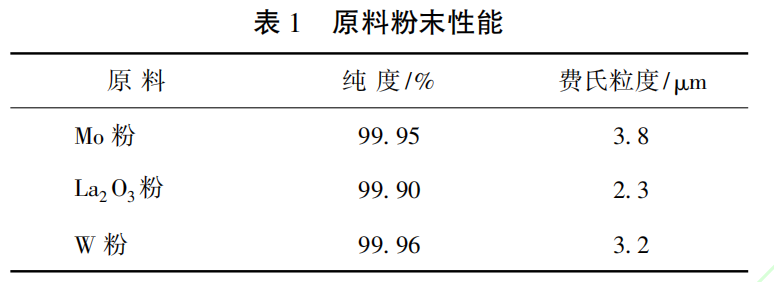
The microstructure and performance of the plates annealed at different annealing temperatures were analyzed. The samples were taken to make metallographic samples. NaOH and K3Fe(CN)6 aqueous solutions were used as corrosive agents. The metallographic microstructure of the plates was observed with an Olympus GX51 metallographic microscope; the hardness of the plates was tested with an HVS-50 digital Vickers hardness tester; the room temperature tensile properties were tested with a 20T CMT5205 electronic universal tensile machine, and the implementation standard was: GB/T 228.1-2021 Metallic materials tensile test Part 1: Room temperature test method; the fracture characteristics of the room temperature tensile specimens after the test were observed with a JSM-6510A scanning electron microscope, with a magnification of 1000 times.
2 Results and analysis
2.1 Study on the microstructure of molybdenum and molybdenum alloy plates
The change of microstructure plays a key role in regulating the mechanical properties of alloys. Figures 1 to 3 show the metallographic structures of Mo plate, MoLa plate and Mo-50W plate at different annealing temperatures. In Figure 1, the metallographic structure of Mo plate at 900 °C is long and thin, indicating that recrystallization has not occurred at this temperature; small recrystallized particles begin to appear at 1000 °C, indicating that the structure begins to recrystallize and the recrystallized particles are obvious; when the annealing temperature is 1100 °C, the metallographic structure of Mo plate has almost no long and thin fibrous structure, indicating that the structure has completed the grain recrystallization process at this temperature, and then the recrystallized particles grow with the increase of temperature. In Figure 2, when the annealing temperature of the MoLa plate is 1000℃, the structure is still fibrous; the recrystallization process is completed at the annealing temperature of 1200℃, and then with the increase of annealing temperature, the recrystallized particles grow and the density of the grains increases. In Figure 3, the structure of the Mo-50W plate is a slender fibrous structure at the annealing temperature of 900-1300℃, and recrystallization does not occur until the annealing temperature is 1400℃, and the recrystallization is completed at 1500℃.
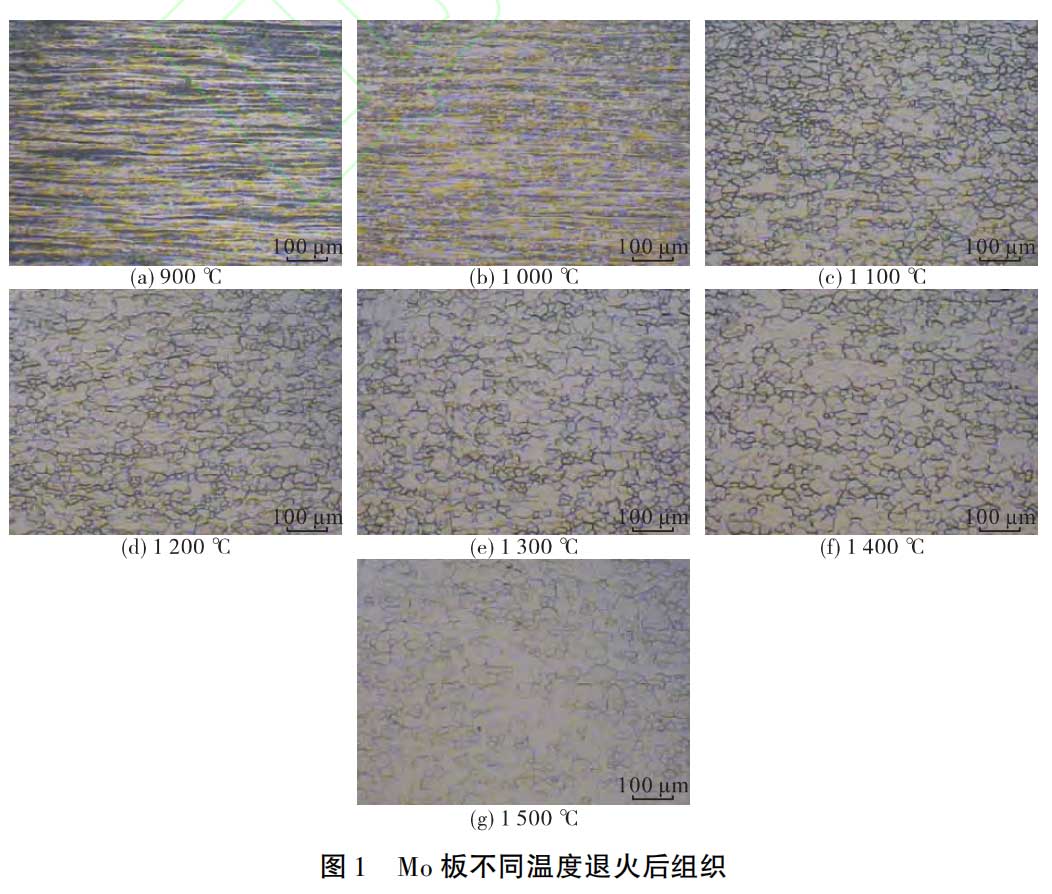
The above results show that: Mo plate basically completes recrystallization at 1100℃; the recrystallization annealing temperature of MoLa plate is about 100℃ higher than that of Mo plate, mainly because the addition of La2O3 can refine the molybdenum grains, and the grains are relatively small and uniform[14]; Mo-50W plate begins to recrystallize at 1400℃, mainly because Mo and W belong to the same group of elements, with similar atomic radius and body-centered cubic structure, which can achieve infinite mutual solubility. After solid solution strengthening, the atomic bonding force is enhanced, which delays the formation of recrystallization core, so the recrystallization temperature of Mo-50W plate is higher.
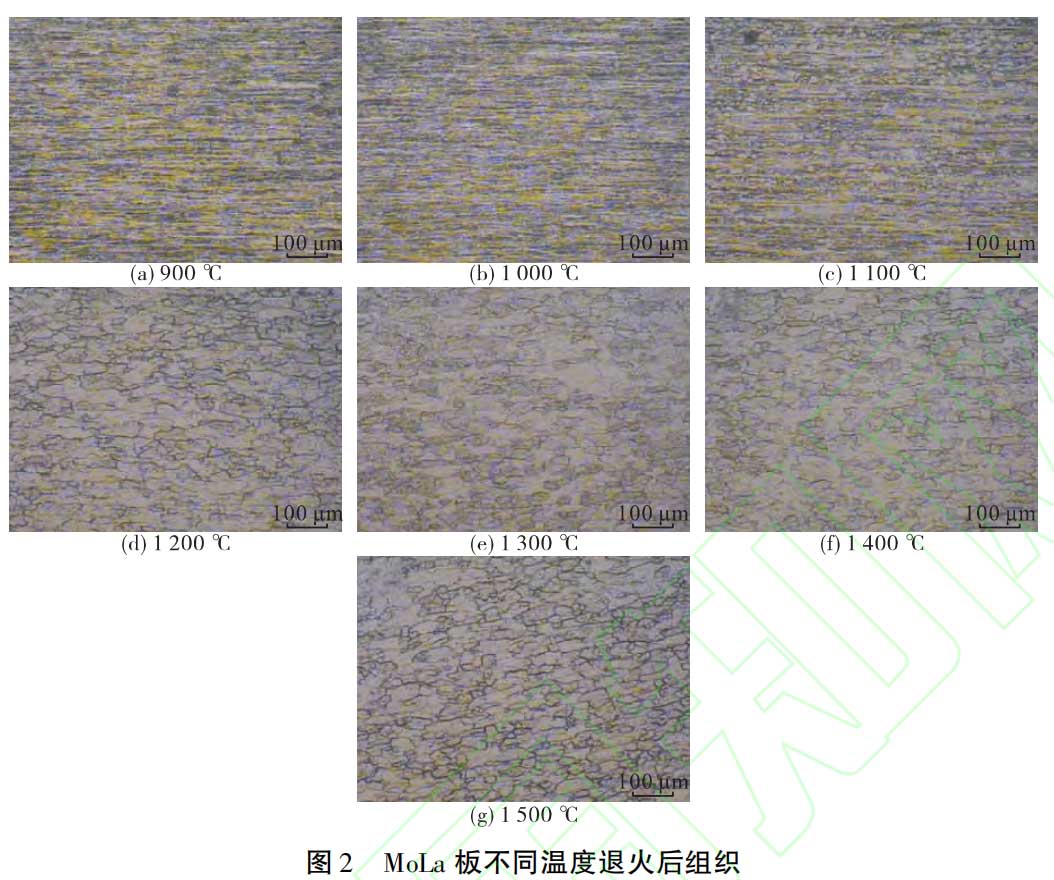
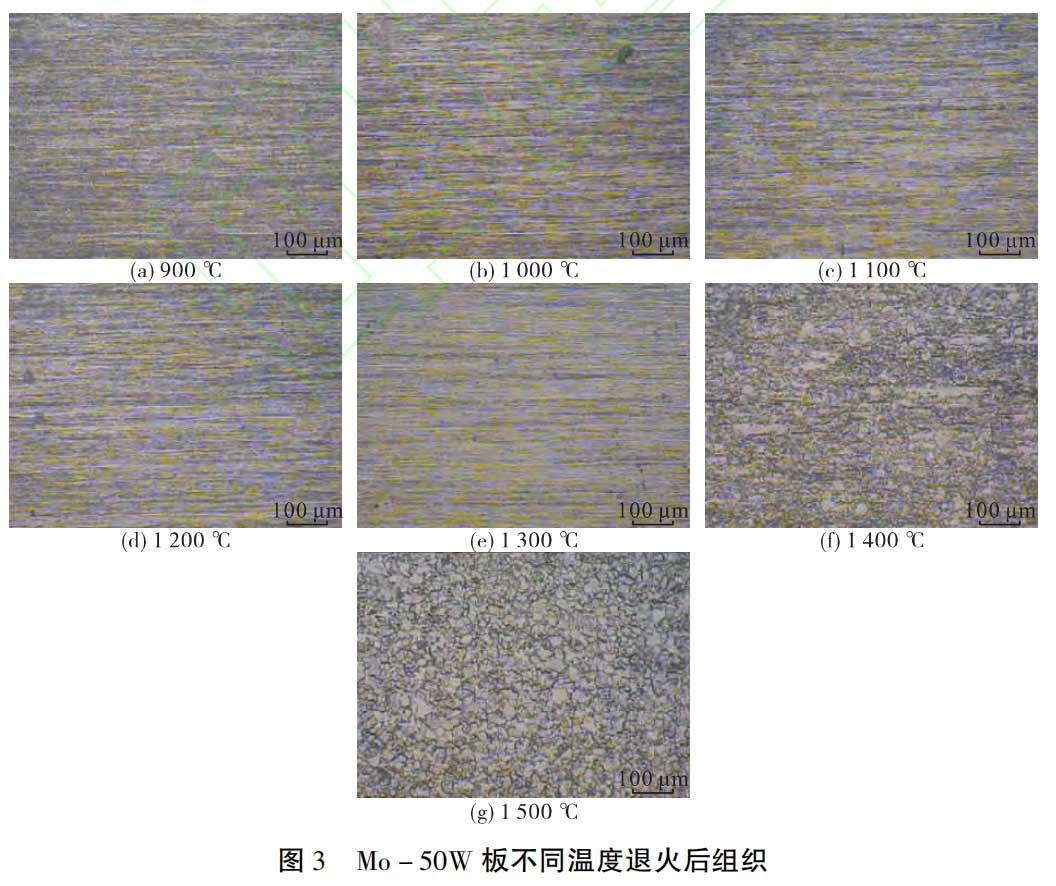
2.2 Study on mechanical properties of molybdenum and molybdenum alloy plates
The hardness test was carried out on the plates formed by sampling Mo plate, MoLa plate and Mo-50W plate at different annealing temperatures, and the test results are shown in Figure 4. It can be seen from Figure 4 that the hardness value of Mo-50W plate is the largest, significantly higher than that of Mo plate and MoLa plate. It shows a gradual downward trend with the increase of annealing temperature, and the downward trend is getting bigger and bigger. The hardness value difference between Mo plate and MoLa plate is small. The hardness change trend can also be seen from the microstructure. The smaller the grain of Mo-50W plate after recrystallization, the more grain boundaries there are. The grain boundaries will block the movement of dislocations. The more grain boundaries there are, the greater the obstruction to the movement of dislocations, and the higher the hardness. Mo plate after annealing at 1100℃ undergoes recrystallization. At this time, the work hardening is quickly eliminated and the internal stress disappears, so the hardness value drops significantly.
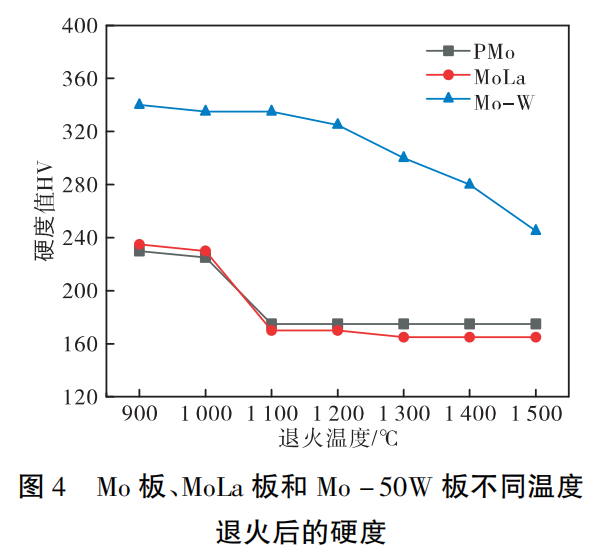
Samples of molybdenum and molybdenum alloy plates annealed at different annealing temperatures were taken and room temperature tensile tests were carried out. The test results are shown in Figures 5 and 6. It can be seen from Figures 5 and 6 that at the same temperature, the room temperature tensile strength of Mo-50W plate is the largest, and the room temperature tensile strength of Mo plate is the smallest. When the annealing temperature of Mo-50W plate is 1500℃, the tensile strength of Mo-50W plate decreases from 834.05 MPa to 606.50 MPa. The tensile strength data is consistent with the literature [15]. The tensile strength of MoLa plate gradually decreases with the increase of annealing temperature. The tensile strength of Mo plate is the smallest when the annealing temperature is 1100℃, because the work hardening inside the material is quickly eliminated and completely recrystallized.
The room temperature tensile strength of Mo-50W plate is relatively large because the addition of tungsten element to molybdenum alloy can improve the bonding force between atoms of molybdenum alloy and form a solid solution. The solute atoms dissolved in the solid solution cause lattice distortion, and the resistance to dislocation movement increases, making displacement difficult, so the tensile strength is relatively large. The room temperature tensile strength of MoLa plate is second, mainly because after La2O3 is doped in the molybdenum alloy, under the dual effects of fine grain strengthening and second phase particle strengthening, the resistance to dislocation movement is increased, and the resistance to material deformation is increased, so the room temperature tensile strength is increased.
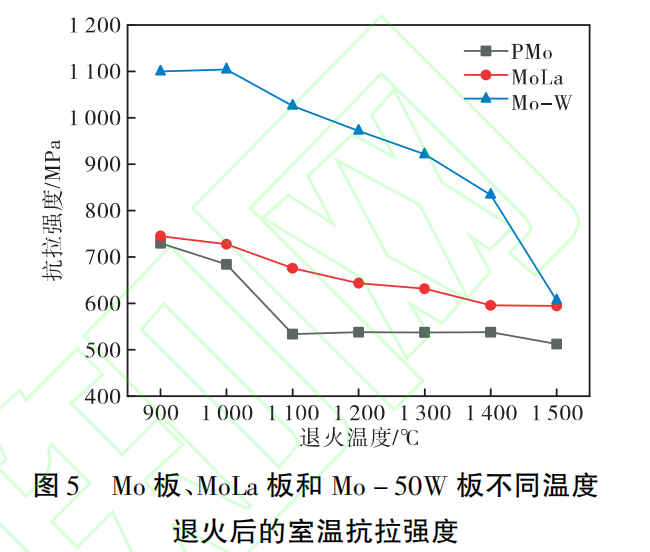
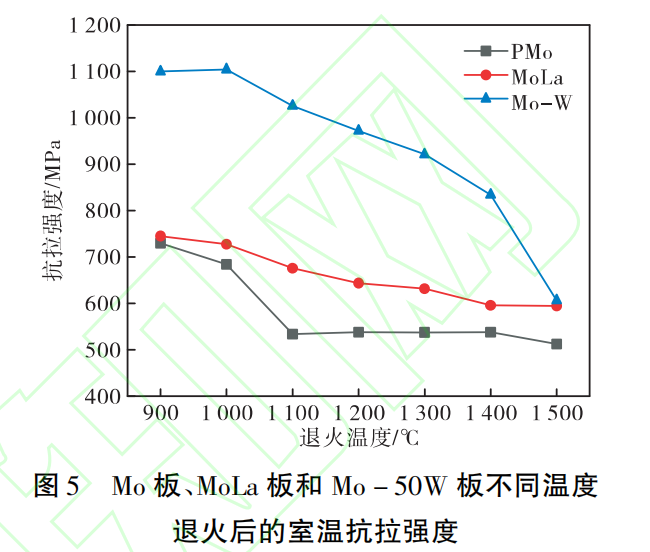
The room temperature tensile fracture morphology of molybdenum and molybdenum alloy plates at different annealing temperatures is shown in Figures 6 to 8. It can be seen from Figures 6 to 8 that the fracture morphology of Mo plate is gray fibrous when the annealing temperature is 900 ℃, with dimples and shear lips, which is ductile fracture; when the annealing temperature is 1 000 ℃, the pure molybdenum plate structure begins to recrystallize, and the fracture mode of the sample is mainly ductile fracture, accompanied by intergranular fracture; when the annealing temperature is 1100 ℃, the structure has completed the recrystallization process, the fracture morphology is rock candy-like fracture, and the fracture mode is intergranular fracture.
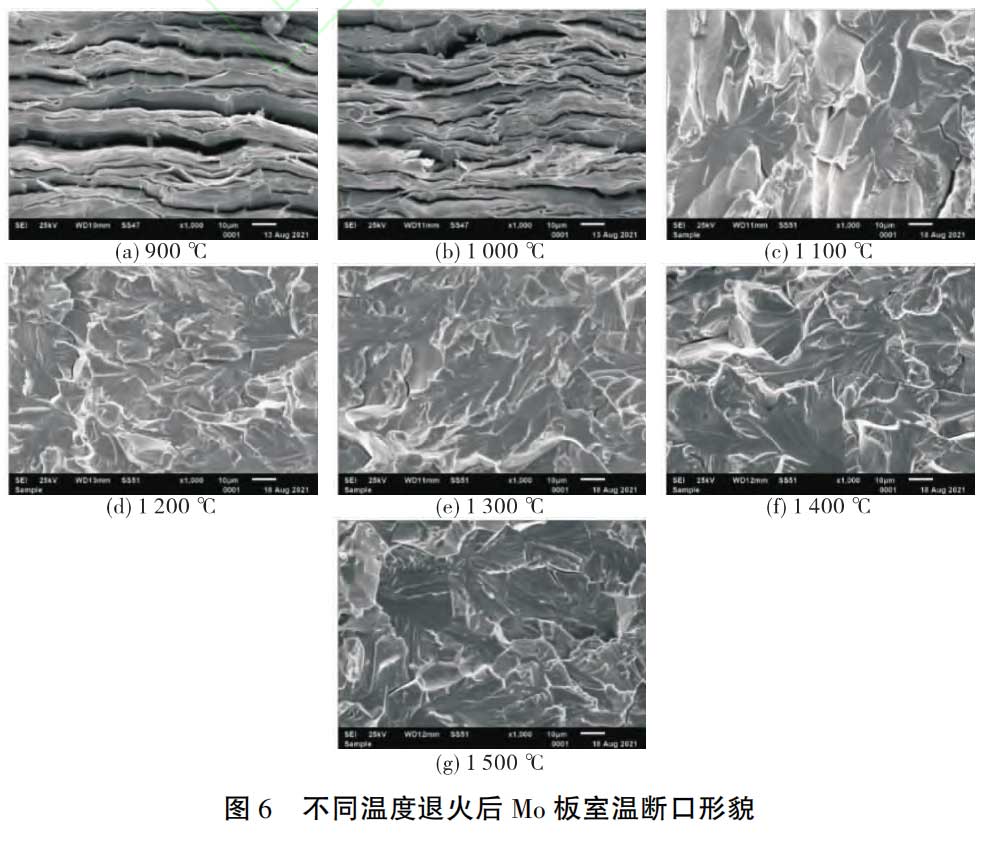
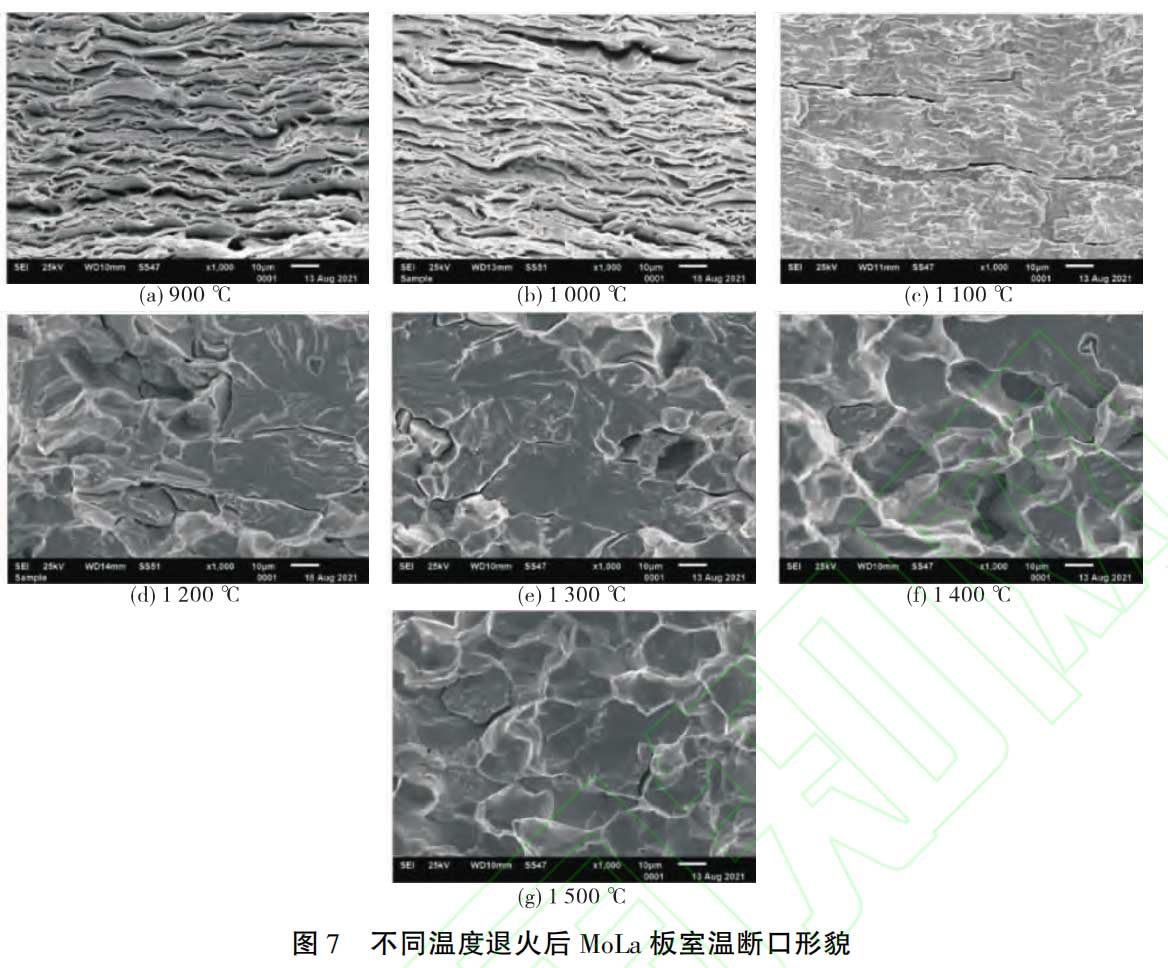
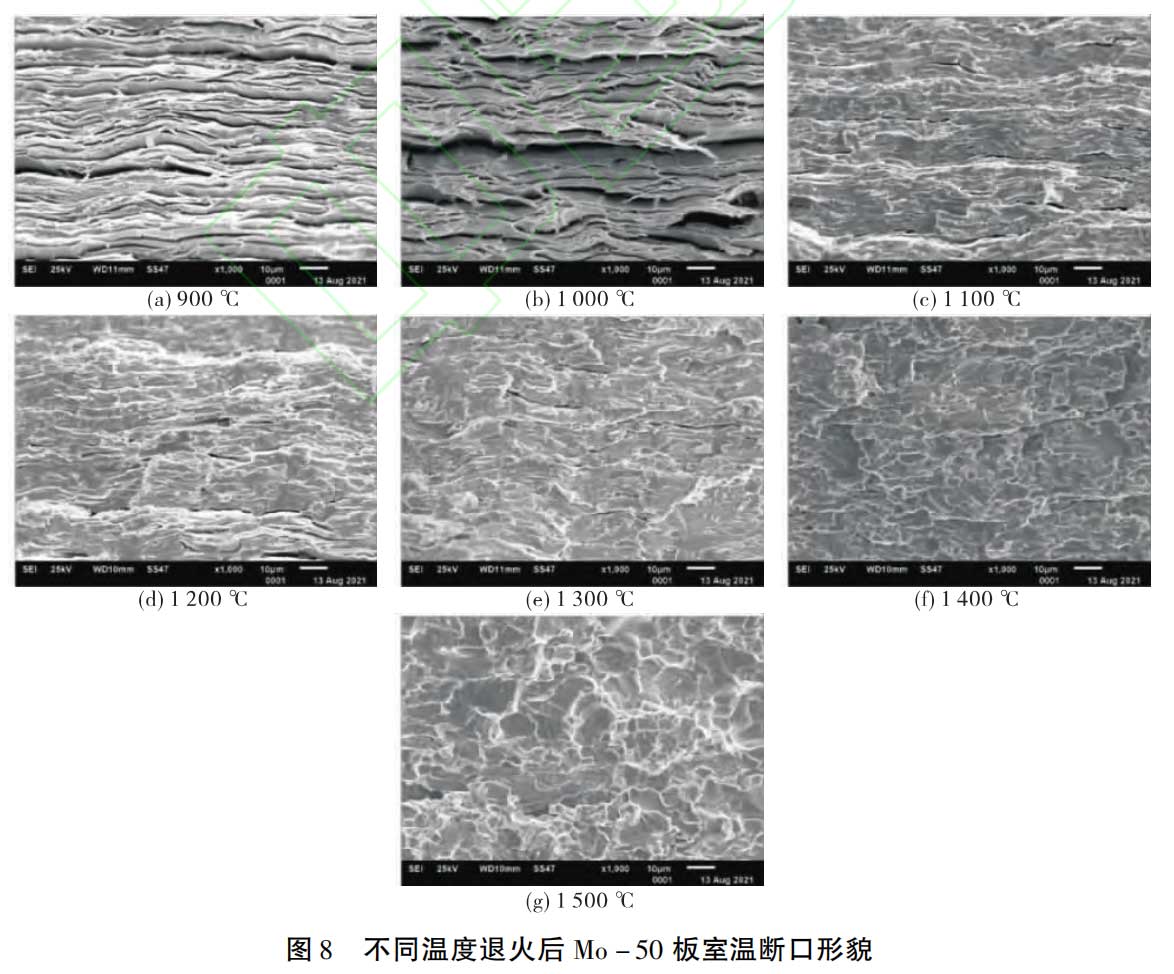
When the annealing temperature of MoLa plate is 900℃ and 1000℃, the fracture morphology has dimples and shear lips, and the analysis shows that it is ductile fracture. When the annealing temperature is 1100℃, the fracture is mainly brittle fracture, and there is still a small amount of transgranular fracture; when the annealing temperature is 1200℃, the MoLa alloy plate has completed the recrystallization process, and the fracture mode is intergranular fracture. When the annealing temperature of Mo-50W plate is below 1300℃, the fracture mode of the fracture morphology is ductile fracture. With the increase of annealing temperature, the density of the organization gradually increases, the toughness increases, and the fracture morphology gradually becomes compact; when the annealing temperature is 1400℃, the toughness of Mo-50W plate suddenly decreases, and the fracture mode is basically intergranular brittle fracture; when the annealing temperature is 1500℃, the organization recrystallizes, and the fracture morphology is like rock candy, judging that the fracture mode is intergranular brittle fracture.
3 Conclusion
1) Mo plate begins to recrystallize at 1000℃ annealing temperature and basically completes recrystallization at 1100℃; the recrystallization annealing temperature of MoLa plate is about 100℃ higher than that of Mo plate; Mo-50W plate begins to recrystallize at 1400℃.
2) The hardness value of Mo-50W plate is significantly higher than that of MoLa plate, and the change of MoLa plate is not obvious compared with Mo plate.
3) The tensile strength of the three molybdenum and molybdenum alloy plates decreases with the increase of annealing temperature, among which the tensile strength of Mo-50W plate is higher.
About Stardust Technology
Stardust Technology (Guangdong) Co., Ltd. is a national high-tech enterprise specializing in the research, development, production and sales of high-end spherical powder materials for 3D printing, powder metallurgy, surface engineering and other fields. The company insists on taking radio frequency plasma spheroidization powder making technology as the core and providing internationally advanced powder products and application solutions.
The company's main products include high-end rare refractory metals such as tungsten, molybdenum, tantalum, niobium, vanadium, rhenium, chromium and their alloys, compound spherical powders, and also provides technical services such as radio frequency plasma spheroidization, plasma rotating electrode atomization, 3D printing, hot isostatic pressing, injection molding, powder metallurgy, etc.
The spherical molybdenum powder prepared by Stardust Technology using radio frequency plasma spheroidization technology has high purity, low oxygen content, high sphericity, smooth surface, no satellite balls, exposed hollow particles, uniform particle size distribution, excellent flow properties, high bulk density and tap density. It is widely used in contact materials, aerospace high temperature resistant components, target materials and other fields. Spherical molybdenum powder is suitable for laser/electron beam additive manufacturing, laser direct deposition, hot isostatic pressing, injection molding, laser cladding and other processes.
https://www.stardustpowder.com/spherical-pure-mo-powder
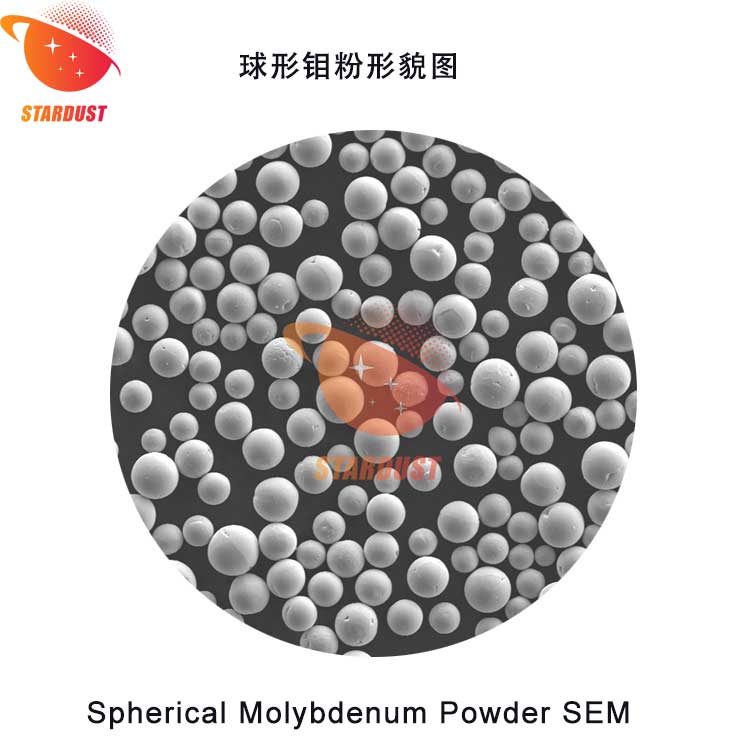
For more details, please contact us
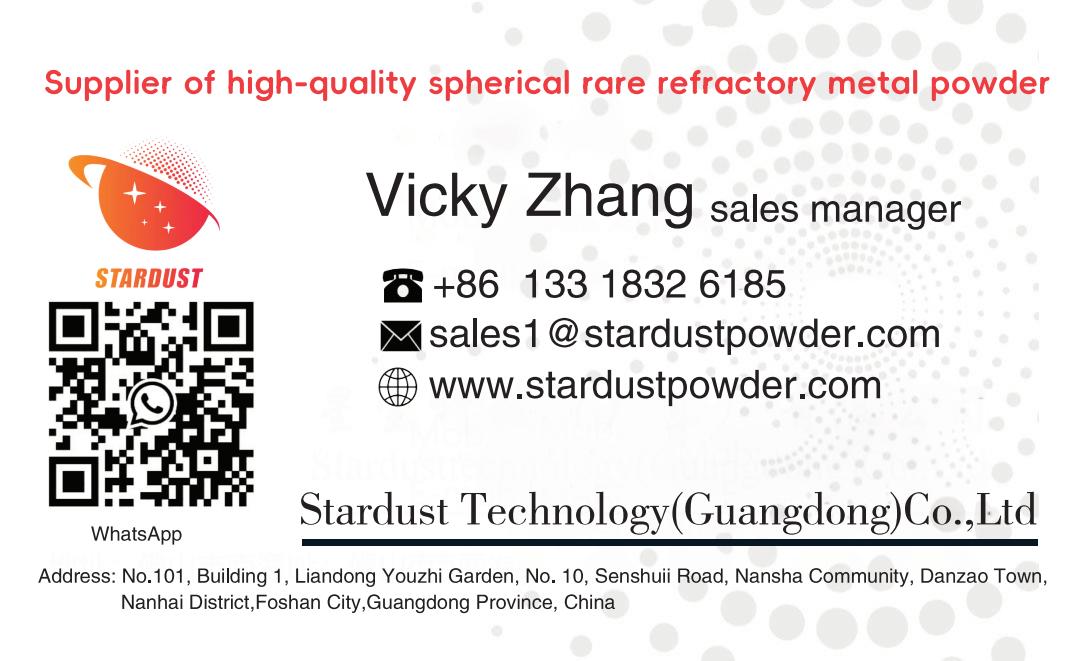
Paper citation information
China Molybdenum Industry
ISSN 1006-2602,CN 61-1238/TF
Chinese Library Classification Number: TG146. 4 Document Identification Code: A